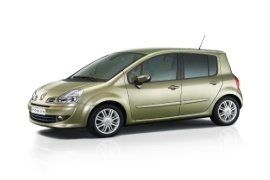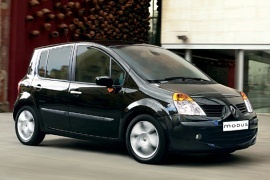
RENAULT Modus
Generations Timeline, Specs and Pictures

As the leading French MPV-maker, Renault didn’t want to throw the towel over the Modus and refreshed it in 2008, improving its design and drivetrains.
There were just a few small-sized MPVs on the European car market in 2008, and the Modus benefited from Renault’s experience in building them. Moreover, Nissan helped a bit with their expertise in the Japanese kei-car segment. But that wasn’t enough to keep the Modus’ engines running for a second generation, but it survived for a facelift and the world financial crisis.
With the introduction of a new Clio, Renault tried to pass on the brand awareness of its small-segment hatchback to the Modus and installed a similar pair of headlights on the front fascia. Yet, the short and steep hood didn’t help too much. The carmaker installed a wide grille in the apron to cool the engine since the small vents above the bumper were not big enough. The car still had the same shape with a flat vertical liftgate at the back.
Inside, the carmaker kept the same clean design from the Modus Phase I (pre-facelift) but with improved quality. The instrument panel featured an LCD with an orange-on-black design for the speedometer, unlike its predecessor, which used a black-on-white display. Since Renault built it on top of a Clio platform, it carried over some of the buttons, gear-stick, and switches from it.
Under the hood, Renault refreshed the engine range and retired the 1.4-liter engine, which wasn’t Euro 5 compliant.

The Renault Modus was designed for users looking for practicality and versatility without having to own a big vehicle as the Scenic.
The Modus was rather a combination between a Clio and a Scenic, being taller and shorter than the Clio.
To make sure the practicality of the Modus was at its best, Renault equipped the car with a Triptic seating system - the rear seats were mounted on sliding rails. The rear seats could offer great comfort or increased cargo capacity.
Innovatively, the front passenger seat had a flip up cushion to offer more storage space and prevent objects from rolling over.
To add even more versatility, users could access the load area even in situation where the Modus was parked very close to another car’s nose. The Boot Chute system consisted of a drop-down opening under the rear window of the tailgate.
The Modus scored a 5-star rating at the Euro-NCAP testing, with its 6 airbags and the ISOFIX child seat fixing points.
The Modus was offered with a variety of engine options: a 1.2-liter from power ranging between 65 hp and 74 hp, a 1.4-liter with 97 hp, a 1.6-liter with 111 hp and a Diesel engine, a 1.5 dCi Common Rail with power ranging between 85 hp and 106 hp.























































